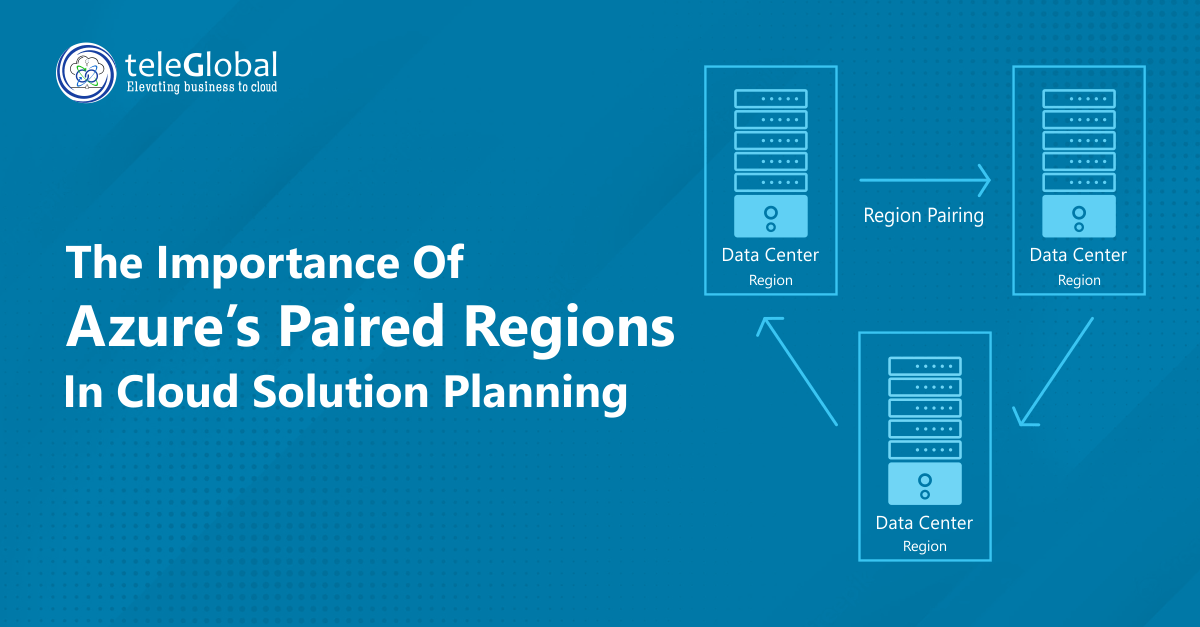
The Importance of Azure’s Paired Regions in Cloud Solution Planning Choosing the ideal Azure Region pair is high up on your checklist when planning your cloud solutions, and as Azure Partners, Teleglobal can help you choose the ideal Azure Region pair for your business; this includes resolving any queries you may have on the technology available to ensure your solution delivers the best results for your business. One of the prime—though often ignored—factors happens to be selecting the best Azure Region pair for your needs.
Paying attention at the outset to choosing the ideal Azure Paired Region helps your business enjoy many benefits, including improved service delivery, lower latency, increased agility, and better cost control.
Teleglobal’s Azure Cloud Consulting services can help you in many ways, be it by boosting innovation and agility using Microsoft Azure cloud, reducing expenses, or creating operational efficiency. Our Azure Cloud consultants work in collaboration with you to leverage this cloud solution to help manage application and infrastructure difficulties, introduce new income streams, and boost productivity.
Benefits of Azure Paired Regions There are five primary advantages your business gains from Microsoft Region pairing, they are, as follows Automatic duplication of services for location-specific storageThis means you don’t need to worry about data loss or data corruption because all your data is copied to the same physical place. You can also regulate the access and manage your storage resources from a single perspective. This consolidation will also help you manage prices across all locations.
Staggered maintenanceMaintenance across Region pairings is staggered to ensure that identical maintenance action does not occur for Azure Paired Region at the same time. This avoids the chance of downtime in your company’s operations.
Assured accessibilityTo support disaster recovery solutions via Regional data replication, Microsoft Azure Region pairs provide significant capacity network backbone links between each area in the pair. This assures accessibility to your data, wherever it may be located.
Physical separation of data centersAs much as possible—some Regions may not support this—Azure separates data centers in a Regional pair by at least 300 miles. This physical separation virtually eliminates the possibility of local issues, like unrest, power failures, or other physical network disruptions, simultaneously affecting both areas.
Prioritized recoveryIn the event of a widespread outage that affects both a pair, Azure prioritizes recovery of one area of each pair. This means that any program operated across Azure Paired Region will always receive priority recovery for one of the Regions. If an application is spread over unpaired areas it may delay. Only in the worst-case scenario would particular Regions be the last two to be restored.
How Azure Regions help your data survive outagesAn Azure Region is roughly the size of a city block. Each Azure Region comprises multiple structures or data centers. And every Region hosts three copies of the data you save there, plus your data is spread across different structures in the Region. This means there is a lot of redundancy inside each physical place. Even in the event of a widespread outage within a Region, the chances are your access would not be impeded.
This ability to mirror data across multiple sites has enabled Microsoft to sail through outages in the past, and it has protected customers from downtime, by creating hardware that promotes redundancy at all levels. This has always been Microsoft’s approach toward virtualization and cloud computing. In short, Azure provides redundant hardware infrastructure (physical hardware) onsite or in remote locations (such as farms or data centers) as well as software infrastructure.
Factors impacting Azure Availability Zone selectionAvailability zones consist of geographically distinct areas inside an Azure Region. Availability zones are linked by fast, proprietary fiber-optic networks. Each Availability zone comprises one or multiple data centers, each one having its power, cooling, and networking. This design acts as a separation barrier, keeping other availability zones operating even if one goes down.
For customers who need to run mission-critical applications, Microsoft Azure provides availability zones with high availability and low-latency replication. As far as latency goes, the closer the Azure Region the lower the network latency. Across industries, latency is no doubt the single biggest factor to be considered when selecting a location for your Azure Availability Zones. The nearest Azure Region to your business is no doubt the most preferable because it will have the lowest network latency between your actual location and Azure.
Conversely, it makes sense to consider an Azure Region further from your actual location if you intend to use Azure for disaster recovery. As this will offer more geographic diversity at a cheaper cost. While latency is an important factor in selecting a location for your Azure Availability Zone—maybe even the most important one, from a business point of view—other considerations are just as critical. The biggest of these is regulatory compliance.
The law of the land often stipulates that data must be stored within a certain location. This should take prime priority in deciding which availability zone to select. Thus it is important to consider the data access laws of the nation hosting the Azure Paired Region you choose because each country has its regulations surrounding government access to data. For instance, US businesses may need to keep their data within the US. Similarly, Indian businesses may be bound by governmental regulations from storing certain data outside the borders of the country.
Need help with cloud migration of services?Teleglobal can help. As Advanced Partners to AWS, and Partners to Azure and Google Cloud Providers, we are ideally positioned to help you across every step of your cloud migration, and that starts with picking the best Availability Zone for your needs. For more assistance, get in touch with us.







































